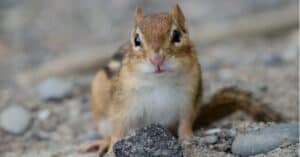Chipmunks are lively little rodents who live solitary lives.
These curious critters prefer to spend their days alone, actively foraging for food on the forest floor. Although they prefer solitary living, one thing can bring chipmunks together: mating season, followed by the joyful arrival of adorable chipmunk babies.
When do chipmunks have babies? Read on to find out.
Baby Chipmunks
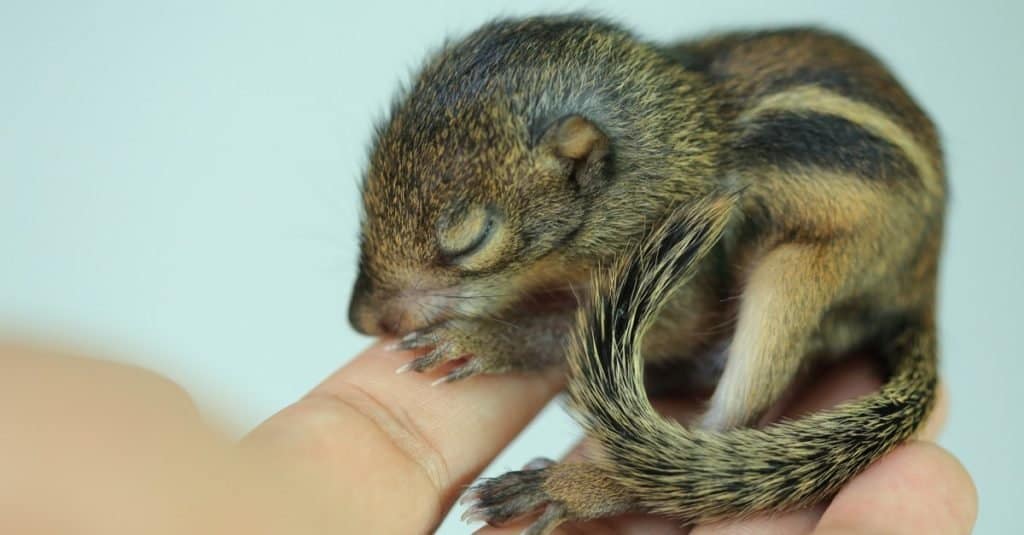
Chipmunks have babies in late spring.
©wanpapha sichana-in/Shutterstock.com
Chipmunks have babies in March and April. Babies arrive in late spring and stay in the nest for up to six weeks. After a gestation period of 31 days, females give birth to a litter of 2 to 6 young. Sometimes the litters are as large as 9 baby chipmunks. One female can give birth to one or two litters in a year.
Chipmunks don’t like hanging out with other chipmunks. They only come together to mate, and the females raise the young.
Mating season happens twice a year. The first season takes place from February to April. The second mating season occurs from June to August.
What do you call a baby chipmunk? Adorable chipmunk babies are called pups. Their dads are called bucks, and their moms are called does. When there’s a group of chipmunks together, it’s a scurry.
Blind and Hairless
Hairless, blind, and helpless; these three words describe baby chipmunks perfectly. They’re also super tiny. Newborn chipmunks are about the size of a bumblebee.
One of the ways these itty bitty babies survive is by remaining hidden. When chipmunks have babies, the young stay underground in the burrow for 6 weeks. After approximately 8 to 10 weeks, they are fully independent.
Growing Up

Chipmunk moms kick their young out of the burrow when they’re 10 weeks old.
©iStock.com/rodmacpherson
Chipmunk moms have a big job to complete. They are responsible for caring for the young and then kicking them out of the house when they’re grown.
Under their mother’s watchful eye, the pups take short trips out of the burrow. This happens when they’re around 6 weeks old. Then, by week 7 or 8, their mom begins acting aggressively toward her young.
Switching from being maternal and caring to being mean is a survival technique to prepare them for independence. If they don’t get the message, it becomes clear when they’re kicked out of the house.
By the time they’re 10 weeks old, the mother denies them access to the burrow. No more free lodging and no more free meals. The young are forced to go into the world and find their own food.
Pups are usually fully grown after 8 weeks and mature by 4 to 6 months. When do these chipmunks have babies of their own? Not for at least a year when they reach sexual maturity.
Chipmunk Behavior
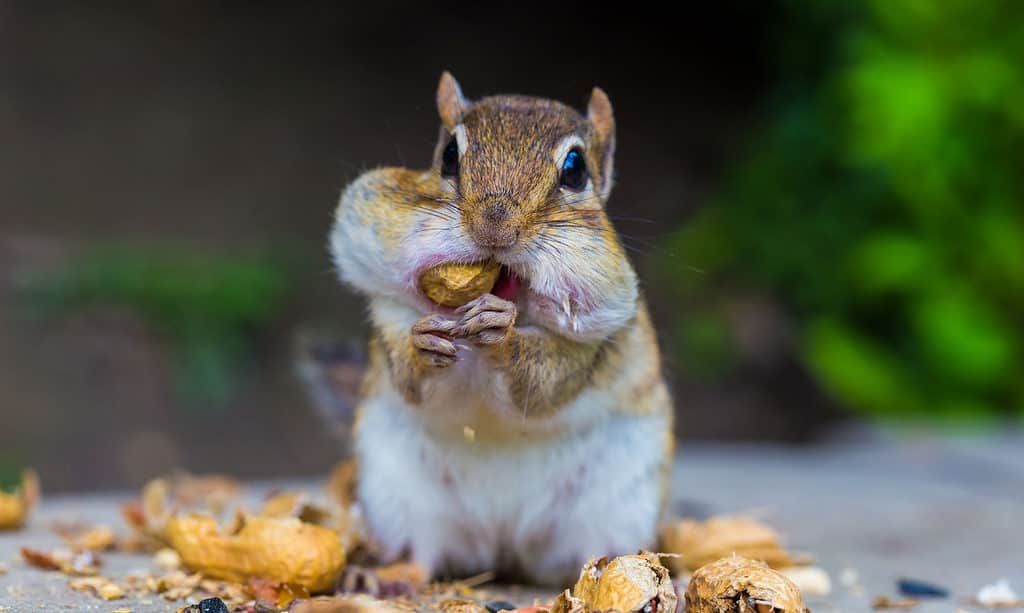
Chipmunks can stuff four large nuts in each cheek pouch.
©colacat/Shutterstock.com
Chipmunks are natural hoarders who love stuffing their cheek pouches with tasty snacks. Their cheek pouches can stretch to nearly the size of their head. One chipmunk can fit four big nuts in each cheek pouch.
If you’ve ever seen a chipmunk nibbling on a nut, it’s probably not eating it. Instead, they’re preparing the tasty morsel for travel by breaking off the sharp edges.
Sitting upright, they’ll hold the nut carefully in their front paw. Then they expertly bite off any sharp edges or stems. Once the rough bits are gone, they stuff their cheek pouch and return the food to the burrow.
Nuts are just one of the things on a chipmunk’s menu. As omnivores, they feed on both plants and animals. They eat worms, berries, fungi, flowers, seeds, snails, frogs, and more.
When they want to eat something special, they take to the trees. Up high in the limbs, they can steal bird eggs or pick fruit. The Siberian chipmunk uses sharp claws to help it climb and a long tail to keep balance as it searches for food in pine trees.
Why Chipmunks Are Skittish
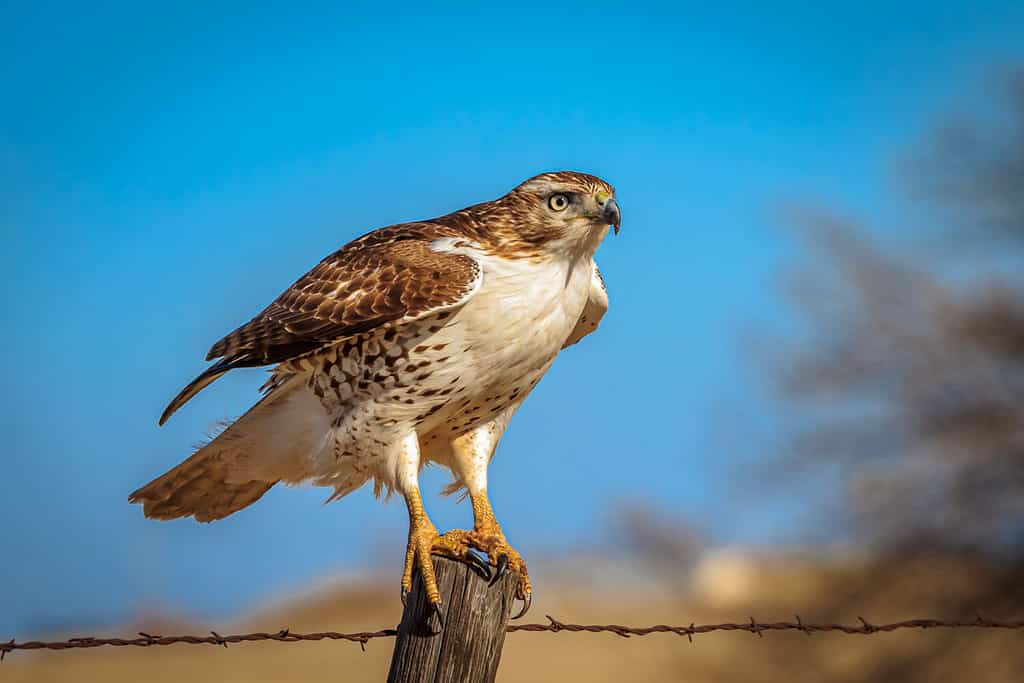
Hawks are one of the many predators that eat chipmunks.
©Richard G Smith/Shutterstock.com
When chipmunks go out to find food, they’re taking the risk of being eaten. That’s why these skittish rodents collect food with small quick movements. They’re constantly stopping to look for predators. House cats, hawks, foxes, raccoons, snakes, owls, bobcats, and coyotes prey on chipmunks.
One of the ways they survive is by using fallen trees, rocks, and bushes as cover. Of course, the best cover is their intricate burrows. Other animals that use burrows to survive include moles, prairie dogs, and badgers.
How Chipmunk Parents Conserve Their Energy
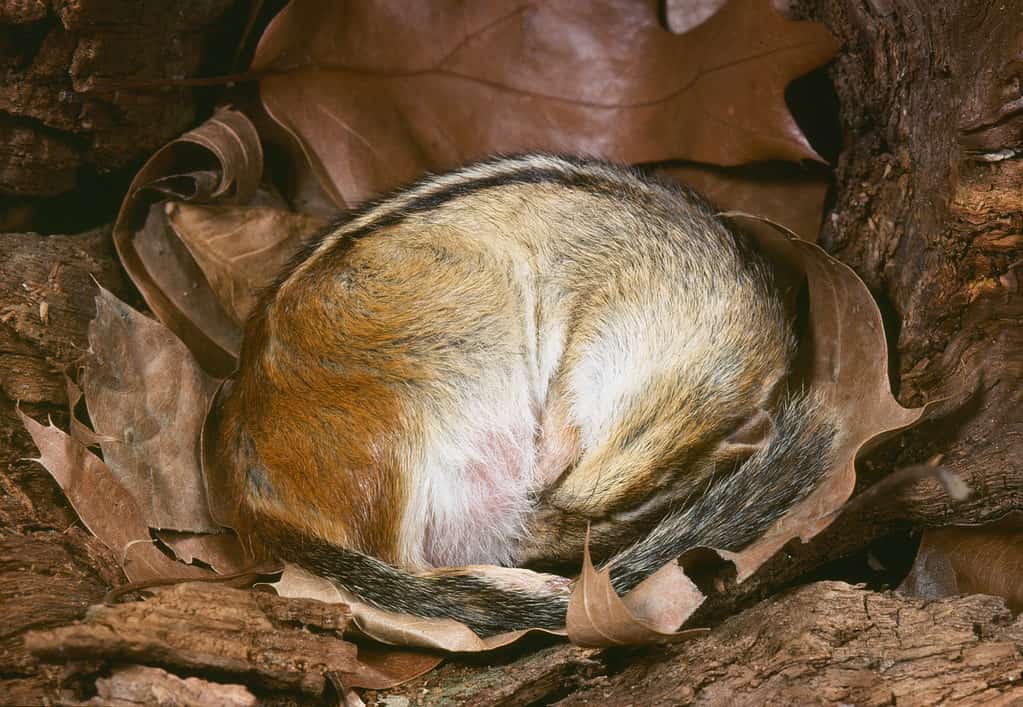
Chipmunks enter into torpor to conserve energy; this happens in late October.
©Breck P. Kent/Shutterstock.com
Being a chipmunk takes a lot of energy! That’s why beginning in late October, they sleep for long periods. This state of inactivity is torpor. Chipmunk moms usually rest longer than males because of the energy they spend while pregnant and nursing. Raising a litter of 2 to 9 pups takes a lot of energy.
During torpor, chipmunks occasionally wake on warm days. They’ll snack on stored nuts and seeds and may even come outside for short periods. Using a keen sense of smell, they can locate their stores. Sometimes chipmunks store as much as 8 pounds of nuts, seeds, and acorns to survive the winter. These foods are rich in fatty acids and help replenish their bodies and boost energy levels.
Sometimes chipmunks are forgetful and can’t find some of their stored food. This mistake pays off for future generations. The forgotten seeds and nuts sprout into new trees, providing fresh food for the entire ecosystem.
Chipmunk Lifespan and Habitat
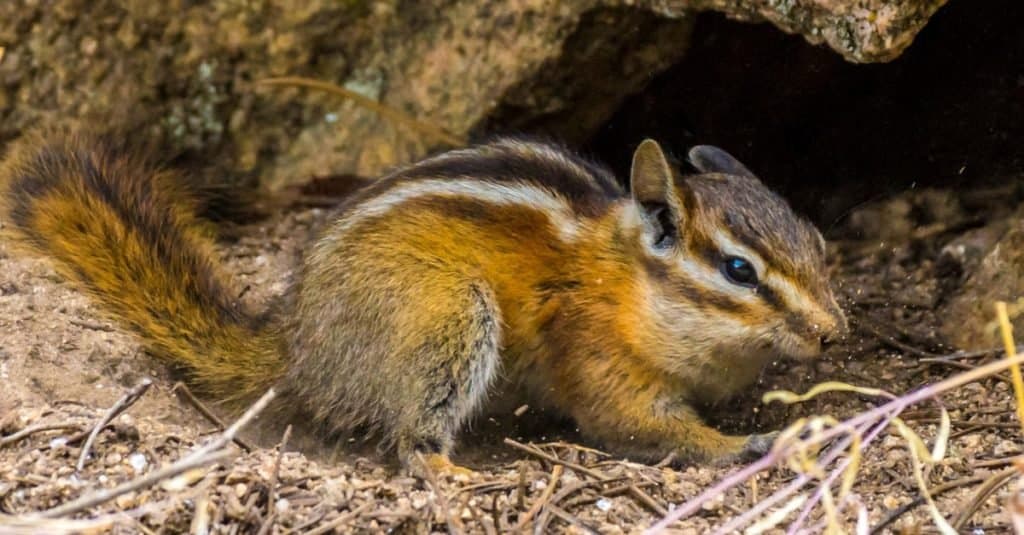
Chipmunks live for about three years and spend most of that time underground.
©Ryan Narron/Shutterstock.com
Chipmunks don’t live very long. A 3-year-old chipmunk would be considered a senior citizen. Since their lifespan is short, they start reproducing at one year old.
These rodents cover less than half an acre of habitat during their lifespan. And they spend most of that time underground in their burrows. These safe havens extend from 18 to 36 inches below the surface and can reach more than 30 feet long.
The burrow entrance is only about 2 inches wide. They remove fresh dirt from the opening using their little paws to deter predators. And they’re very territorial about sharing their space with other chipmunks.
Chipmunk Communication: Warning Kin About Danger
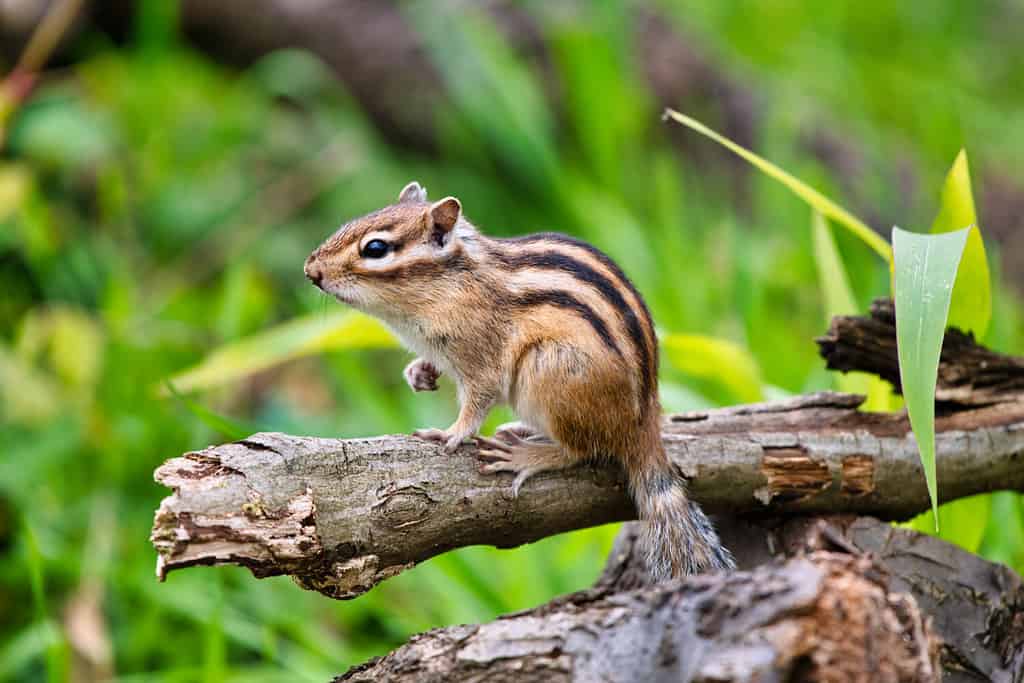
Chipmunks use different sounds to alert others if a predator is nearby.
©Tatsuya Nishizaki/Shutterstock.com
They may be territorial, but chipmunks watch out for their own kind. One of the ways they help keep each other safe is by using different sounds to announce danger.
If a chipmunk detects a predator, it sounds an alarm. Sharp calls mean the predator is on the ground. Lower-pitched calls signal danger from the air.
Charline Couchoux, a biologist, studied eastern chipmunks to learn more about these warning calls. Using super small digital audio recorders, she was able to track the chipmunks’ vocalizations.
The recorders were modified from espionage technology, which made them perfect for this study. They were lightweight, weatherproof, and highly sound-sensitive.
Researchers fitted 21 chipmunks with the recorder collars and then tracked them for 24 hours. The study’s goal was to identify how chipmunks communicate with each other. The results prove chipmunks use specific calls to communicate danger, signaling threats from the ground or air.
Thank you for reading! Have some feedback for us? Contact the AZ Animals editorial team.







